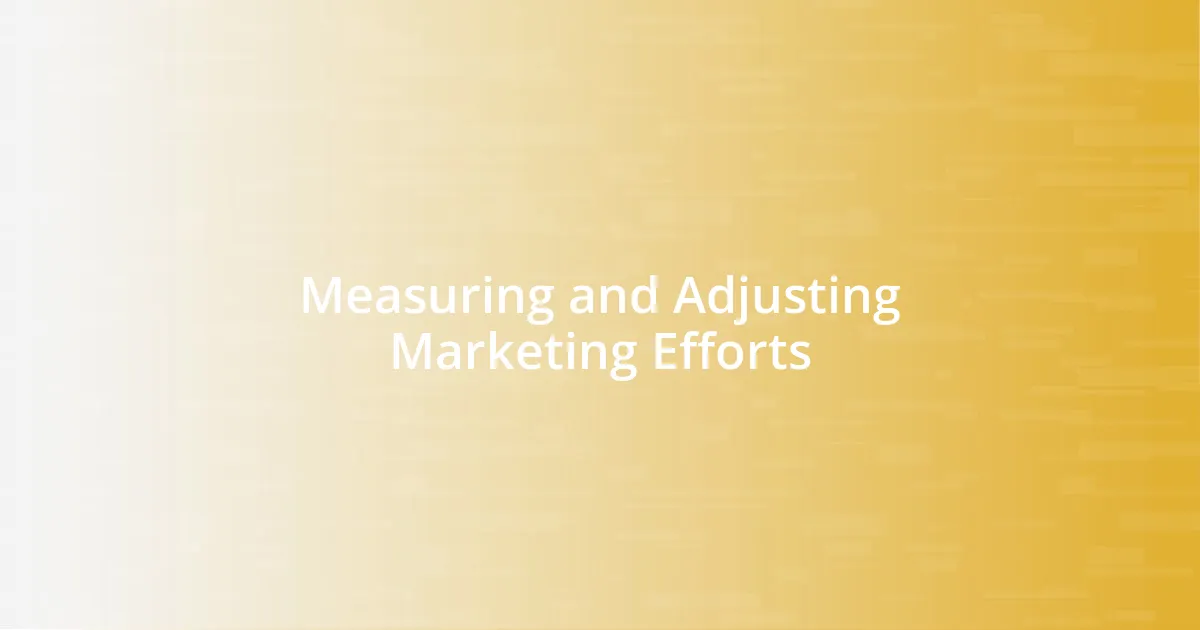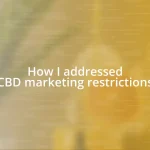Key takeaways:
- CBD marketing is heavily regulated, with varying laws across states, requiring careful compliance and strategic messaging.
- Educational content is essential in navigating restrictions; it builds brand trust and engages audiences meaningfully.
- Collaborating with authentic influencers enhances credibility and fosters deeper connections with consumers.
- Continuous measurement and adjustment of marketing strategies based on audience feedback lead to more effective outreach.

Understanding CBD Marketing Restrictions
Navigating CBD marketing restrictions can often feel like walking a tightrope. I remember the first time I attempted to promote a CBD product online; it was like trying to decode a secret language. The regulations vary widely from state to state and even from platform to platform, which makes it all the more challenging. How do you ensure compliance without stifling your creativity?
The FDA’s stance on CBD is particularly daunting. They haven’t fully accepted CBD as a dietary supplement, which means marketing claims can’t specify health benefits without facing serious repercussions. This left me reflecting on how important it is to strategize marketing messages carefully. Did you know that even using common phrases like “natural remedy” can trigger red flags?
Emotional insights come into play when you consider the impact of these restrictions on small businesses. I’ve felt the frustration of knowing I had a fantastic product that could help so many, yet being restricted in how I could communicate that to potential customers. Isn’t it disheartening when innovation meets bureaucracy? Understanding these limitations not only shapes our strategies but also makes us more resilient marketers.

Researching Legal Frameworks
Researching the legal frameworks surrounding CBD marketing is a necessary step I found crucial in my journey. Initially, I felt overwhelmed by the sheer volume of information—federal, state, and even local laws all play a role. I remember spending nights cross-referencing legal texts, trying to piece together the puzzle. It’s amazing how a small detail, like the difference between hemp-derived CBD and marijuana-derived CBD, can change everything about your marketing approach!
I soon discovered that understanding the nuances of social media policies also shaped our strategies significantly. For example, I learned that platforms like Facebook and Google have strict guidelines regarding the promotion of CBD products. This led me to creatively pivot my campaigns towards educational content, steering away from direct product promotion. Has anyone else experienced that “aha” moment when you realize a setback can turn into an opportunity?
Incorporating findings from legal consultations turned out to be invaluable. After speaking with a lawyer specializing in cannabis law, I identified specific language to use in my marketing that kept me compliant while also resonating with potential customers. It was a relief to have clarity, as I could finally focus on crafting messages that felt authentic and engaging without the looming fear of regulatory backlash. Below is a comparison of key regulations in different states, highlighting the importance of location in understanding marketing restrictions.
| State | CBD Marketing Regulations |
|---|---|
| California | Must disclose CBD source; health claims strictly regulated. |
| Texas | Permit required for sales; no health benefits can be claimed. |
| Colorado | More flexible; can market CBD as a supplement, with some restrictions. |

Identifying Target Audience Effectively
To effectively identify your target audience for CBD marketing, I’ve found a blend of research and intuition is key. There was a moment during my marketing efforts when I realized demographics alone weren’t enough. I began delving deeper into psychographics—understanding my audience’s lifestyle, values, and motivations. This shift transformed my approach entirely, allowing me to connect on a more meaningful level.
Key strategies for pinpointing your target audience include:
- Conducting Surveys: Direct feedback from potential customers can provide invaluable insights into their preferences.
- Analyzing Competitors: Observing who engages with competitors can help identify shared interests within your own audience.
- Utilizing Social Media Analytics: Platforms often provide valuable data about user demographics and engagement patterns.
- Segmenting Your Audience: Create distinct groups based on interests, preferences, or purchase behaviors to tailor your messaging.
This nuanced approach not only improves targeting but also elevates your marketing efforts by fostering authentic connections. I remember crafting a campaign that truly resonated because I found my audience’s pain points—real stories of stress relief and enhanced wellness sparked genuine conversations that drove engagement.

Leveraging Educational Content Strategies
Leveraging educational content strategies has become my go-to method in navigating CBD marketing restrictions. Early on, I realized that instead of outright selling products, I could directly address consumer questions about CBD. I vividly remember creating a series of blog posts debunking myths—like the difference between CBD oil and hemp oil. The feedback was overwhelmingly positive, and people appreciated the clarity. It’s rewarding knowing that with every article, I was not just building my brand but also educating my audience.
In one particular instance, I hosted a webinar focusing on the science behind CBD. Attendees were genuinely curious, sharing their concerns and experiences. This interactive format not only allowed for real-time engagement but also helped demystify CBD for many. Engaging with your audience in this way helps foster a sense of community that can be invaluable. Have you ever participated in a discussion that made you feel more connected to a brand or topic? That sense of belonging is what I aimed to create.
Moreover, I discovered that repurposing educational content further amplified its impact. I took excerpts from my blog posts and transformed them into social media graphics, infographics, or short videos. This multi-channel approach not only allowed me to reach different audience segments but also reinforced key messages across various platforms. It’s amazing how different formats can keep the conversation going and build a richer narrative around CBD. What strategies have you found effective in extending the life of your content? Trust me, experimenting with different formats can lead to unexpected and delightful results!

Utilizing Social Media Safely
When using social media to promote CBD products, I’ve learned that caution is essential. I once posted a video about the benefits of CBD without considering platform guidelines, and it was quickly taken down. This experience taught me the importance of understanding each platform’s rules. Ensuring compliance not only protects your content but also builds trust with your audience.
Navigating the tightrope of safe CBD marketing has led me to prioritize transparency in my social media posts. I remember crafting a message that acknowledged the existing regulations while still sharing valuable information. By clearly stating what our products can do, without making unfounded claims, I noticed a more engaged response from users. Have you ever felt more inclined to interact with a brand that respects regulations? This approach reinforces that mutual respect between businesses and consumers.
Lastly, I realized that being part of the conversation surrounding CBD will often yield better results than merely broadcasting messages. Engaging with comments, responding to questions, and participating in relevant discussions made my brand feel more approachable. It reminds me of how a friend always listens and recalls what you’ve said before. Isn’t that the kind of relationship we hope to create with our audience? Building a community around your brand can significantly enhance loyalty and awareness in this sensitive industry.

Collaborating with Influencers Responsibly
In my journey of collaborating with influencers, I always prioritized authenticity. Once, I teamed up with a wellness influencer whose values echoed my own. She talked openly about her personal experiences with CBD, weaving it seamlessly into her lifestyle. I could really see the genuine connection she had with her audience. It reminded me how important it is for influencers to not just promote a product, but to share their personal stories. When you align with someone who lives and breathes your brand, it creates a narrative that resonates deeply with both their followers and your potential customers.
I’ve also been mindful of the type of influencers I collaborate with. Choosing those who demonstrate expertise in the wellness field has been particularly impactful. I remember a campaign where I worked with a nutritionist who incorporated our CBD products into her meal plans. She not only provided a fresh perspective on how to use CBD, but her followers trusted her recommendations. Have you noticed how expertise can enhance credibility? It’s a powerful reminder that consumers are looking for guidance from voices they already respect.
Lastly, transparency remains at the heart of these relationships. I firmly believe in setting clear expectations right from the start. During a recent partnership, I had an open conversation with the influencer about what we both expected out of the collaboration. This included discussing boundaries around claims and ensuring our messaging aligned with regulatory standards. That candid communication not only strengthened our partnership but also built trust. When influencers feel empowered to share authentically and responsibly, it can lead to amazing results. Isn’t it fascinating how responsible collaborations can elevate not just a brand, but an entire community?

Measuring and Adjusting Marketing Efforts
Measuring the success of my marketing efforts has been an enlightening process. I remember the first time I analyzed social media engagement through metrics such as likes, shares, and comments. Each number told a story about what my audience valued, leading me to pivot my content strategy. Have you ever felt like a simple number transformed your approach? It’s astonishing how data can guide decisions, making adjustments feel less like guesswork and more like targeted efforts.
Adjusting my marketing approach, based on real-time feedback, became an essential part of my strategy. For instance, after launching a particular campaign, I noticed a dip in engagement. Instead of being discouraged, I viewed it as an opportunity to learn. I reached out to my audience through polls and direct messages, asking them what they wanted to see more of. Their insights not only rejuvenated my content but also strengthened our connection. Isn’t it amazing how listening to your audience can reshape your entire narrative?
I also discovered that A/B testing was a game-changer for my marketing efforts. I distinctly recall running two versions of an ad, each with different messaging. This experiment revealed that straightforward, educational content resonates deeper than flashy promotions. It was a surprise, but it underscored the significance of clarity and authenticity in my marketing strategy. Have you considered using A/B testing to refine your own strategies? The experience taught me that being adaptable and willing to experiment can lead to remarkable insights.













